The Cambridge History of China. Vol. 06. Alien Regimes and Border States, 907-1368
Подождите немного. Документ загружается.

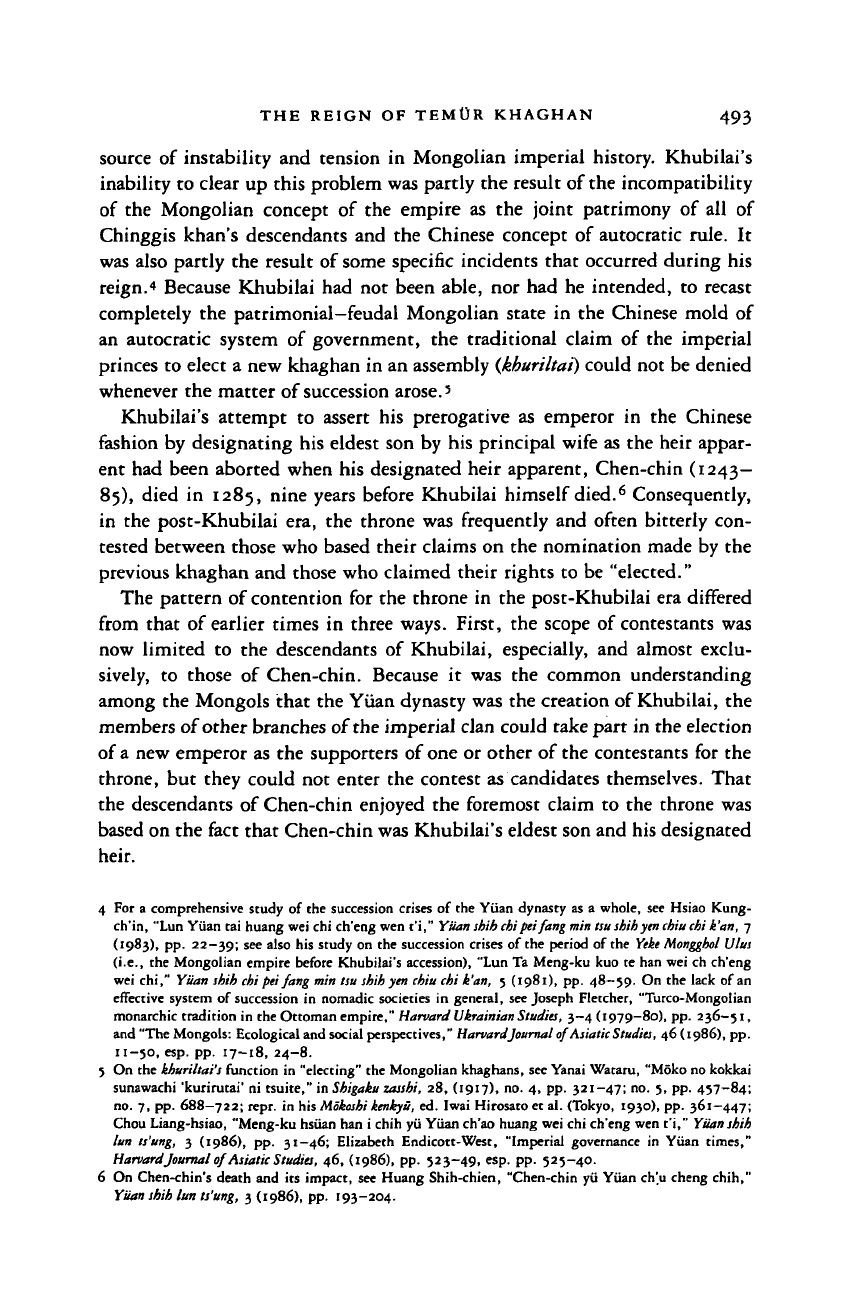
THE REIGN OF TEMOR KHAGHAN 493
source of instability and tension in Mongolian imperial history. Khubilai's
inability to clear up this problem was partly the result of the incompatibility
of the Mongolian concept of the empire as the joint patrimony of all of
Chinggis khan's descendants and the Chinese concept of autocratic rule. It
was also partly the result of some specific incidents that occurred during his
reign.
4
Because Khubilai had not been able, nor had he intended, to recast
completely the patrimonial—feudal Mongolian state in the Chinese mold of
an autocratic system of government, the traditional claim of the imperial
princes to elect a new khaghan in an assembly (khuriltai) could not be denied
whenever the matter of succession arose.
5
Khubilai's attempt to assert his prerogative as emperor in the Chinese
fashion by designating his eldest son by his principal wife as the heir appar-
ent had been aborted when his designated heir apparent, Chen-chin
(1243-
85),
died in 1285, nine years before Khubilai himself died.
6
Consequently,
in the post-Khubilai era, the throne was frequently and often bitterly con-
tested between those who based their claims on the nomination made by the
previous khaghan and those who claimed their rights to be "elected."
The pattern of contention for the throne in the post-Khubilai era differed
from that of earlier times in three ways. First, the scope of contestants was
now limited to the descendants of Khubilai, especially, and almost exclu-
sively, to those of Chen-chin. Because it was the common understanding
among the Mongols that the Yuan dynasty was the creation of Khubilai, the
members of other branches of the imperial clan could take part in the election
of a new emperor as the supporters of one or other of the contestants for the
throne, but they could not enter the contest as candidates themselves. That
the descendants of Chen-chin enjoyed the foremost claim to the throne was
based on the fact that Chen-chin was Khubilai's eldest son and his designated
heir.
4 For a comprehensive study of the succession crises of the Yuan dynasty as a whole, see Hsiao Kung-
ch'in,
"Lun Yuan tai huang wei chi ch'eng wen t'i," Yuanshih chipeifangmin tsushihyenchiu
chi
k'an, 7
(1983),
pp. 22-39; see also his study on the succession crises of the period of the
Yeke Mongghol
Ulus
(i.e.,
the Mongolian empire before Khubilai's accession), "Lun Ta Meng-ku kuo te han wei ch ch'eng
wei chi," Yuan shih
chi
pei fang min tsu shih yen chiu chi k'an, 5 (1981), pp. 48-59. On the lack of an
effective system of succession in nomadic societies in general, see Joseph Fletcher, "Turco-Mongolian
monarchic tradition in the Ottoman empire," Harvard Ukrainian
Studies,
3-4(1979-80), pp. 236—51,
and "The Mongols: Ecological and social perspectives," Harvard journal of Asiatic
Studies,
46(1986), pp.
11-50,
esp. pp. 17-18, 24-8.
5 On the khuriltai's function in "electing" the Mongolian khaghans, see Yanai Wataru, "Moko no kokkai
sunawachi 'kurirutai' ni tsuite," in Shigaku zaisbi, 28, (1917), no. 4, pp. 321-47; no. 5, pp. 457-84;
no.
7, pp. 688-722; repr. in his Moioshi
kenkyu,
ed. Iwai Hirosato et al. (Tokyo, 1930), pp. 361-447;
Chou Liang-hsiao, "Meng-ku hstian han i chih yii Yuan ch'ao huang wei chi ch'eng wen t'i," Yuan shih
lun ts'ung, 3 (1986), pp. 31—46; Elizabeth Endicott-West, "Imperial governance in Yuan times,"
Harvard Journal of Asiatic
Studies,
46, (1986), pp. 523—49, esp. pp. 525-40.
6 On Chen-chin's death and its impact, see Huang Shih-chien, "Chen-chin yii Yuan ch'u cheng chih,"
Yuan shih lun ts'ung, 3 (1986), pp. 193-204.
Cambridge Histories Online © Cambridge University Press, 2008

494 MID-YOAN POLITICS
Second, the powerful bureaucratic faction in the court played an increas-
ingly important role in creating new khaghans at the expense of the imperial
clansmen.~>
In the traditional Mongolian system it
was
the imperial princes and
consorts who had decided the "electoral" process. Officials
(noyad)
had partici-
pated in the
khuriltai as
the retainers of imperial clansmen, but they were never
allowed to have an independent voice. The increasingly important role played
by the bureaucrats in this regard was clearly the result of Khubilai's effort to
centralize and bureaucratize the government and the consequent weakening of
the patrimonial—feudal character of the Yuan government.
Third, the succession to the throne was often contested, and it alternated
between candidates based in China, who normally enjoyed bureaucratic sup-
port at the capital, and candidates based in the steppe, who usually com-
manded a powerful field army. Such alternations between candidates of sharply
different interests and backgrounds, coupled with
a
series of very short reigns,
led to wide swings in the government's policies generally and in its cultural
orientation particularly, making the politics of the period very volatile.
TEMUR'S SUCCESSION
The first succession crisis broke out immediately after Khubilai's death in
February 1294, for Khubilai had never established his grandson and Chen-
chin's second son, Temiir (1265-1307), with full credentials as his heir.
After the death of Chen-chin in 1285, the aging Khubilai khaghan appar-
ently could not decide on a successor for quite some time. According to the
Persian historian Rashld al-Dln, it was Temiir's mother and Chen-chin's
principal wife, Kokojin (K'uo-k'uo-chen, also known as Bairan ekechi, or
Po-lan yeh-ch'ieh-ch'ih; d. 1300), who was the active promoter of her son's
cause.
8
However, even though Temiir was given the seal of the heir apparent
in July 1293 when he was sent to Mongolia as the princely overseer of all
forces in the steppe,» he was not given the panoply of an heir apparent that
had previously been accorded to his father. This may have reflected Khubi-
lai's reservations about his grandson's suitability as the future khaghan, for
he knew very well that Temiir was a drunkard.
10
Thus the question of
succession still hung in the balance at the time of Khubilai's death.
7 See Hsiao Kung-ch'in, "Lun Yuan tai huang wei chi ch'eng wen t'i," p. 30.
8 John Andrew Boyle, trans., The
successors
of
Genghis
khan: Translated from the
Persian
ofRasbid al-Din
(New York, 1971), pp.
300-1.
According to Chinese sources, it was the Uighur Buddhist-Confucian
official Atghun Sali (A-lu-hun Sa-li, 1245-1307) who originally suggested to Khubilai that Temiir
would be a suitable heir apparent. See Sung Lien et al., eds., Yiiansbih (Peking, 1976), 130, p. 3177
(hereafter cited as YS).
9 YS, 18, p. 381.
10 Boyle, The
successors
of Genghis than, p. 301; YS, 154, p. 3261.
Cambridge Histories Online © Cambridge University Press, 2008
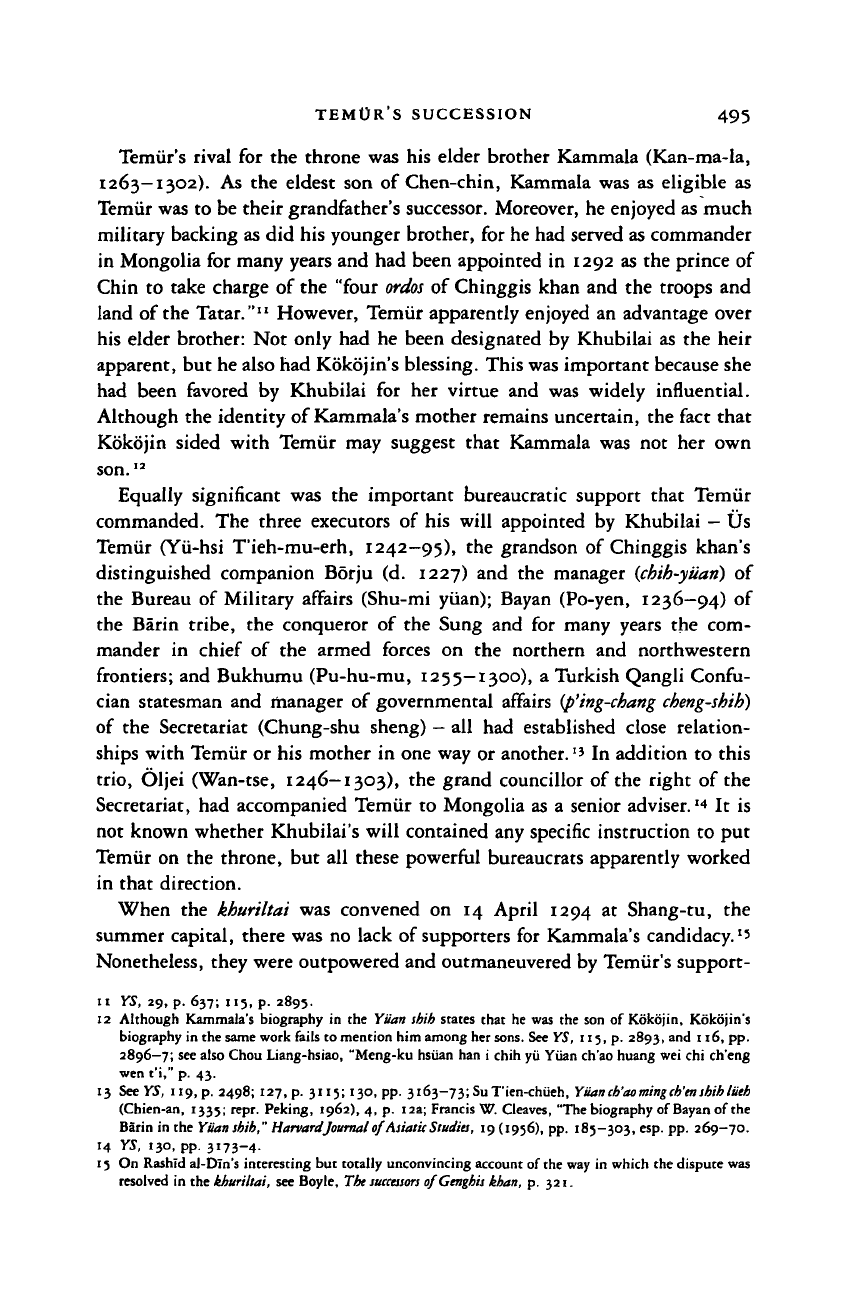
TEMOR'S SUCCESSION 495
Temiir's rival for the throne was his elder brother Kammala (Kan-ma-la,
1263—1302). As the eldest son of Chen-chin, Kammala was as eligible as
Temiir was to be their grandfather's successor. Moreover, he enjoyed as much
military backing as did his younger brother, for he had served as commander
in Mongolia for many years and had been appointed in 1292 as the prince of
Chin to take charge of the "four
ordos
of Chinggis khan and the troops and
land of the Tatar."
11
However, Temiir apparently enjoyed an advantage over
his elder brother: Not only had he been designated by Khubilai as the heir
apparent, but he also had Kokojin's blessing. This was important because she
had been favored by Khubilai for her virtue and was widely influential.
Although the identity of Kammala's mother remains uncertain, the fact that
Kokojin sided with Temiir may suggest that Kammala was not her own
son.
12
Equally significant was the important bureaucratic support that Temiir
commanded. The three executors of his will appointed by Khubilai - Us
Temiir (Yii-hsi T'ieh-mu-erh, 1242—95), the grandson of Chinggis khan's
distinguished companion Borju (d. 1227) and the manager (chih-yiian) of
the Bureau of Military affairs (Shu-mi yuan); Bayan (Po-yen, 1236—94) of
the Barin tribe, the conqueror of the Sung and for many years the com-
mander in chief of the armed forces on the northern and northwestern
frontiers; and Bukhumu (Pu-hu-mu, 1255—1300), a Turkish Qangli Confu-
cian statesman and manager of governmental affairs
(p'ing-chang cheng-shib)
of the Secretariat (Chung-shu sheng) - all had established close relation-
ships with Temiir or his mother in one way or another.
1
' In addition to this
trio,
Oljei (Wan-tse, 1246-1303), the grand councillor of the right of the
Secretariat, had accompanied Temiir to Mongolia as a senior adviser.
14
It is
not known whether Khubilai's will contained any specific instruction to put
Temiir on the throne, but all these powerful bureaucrats apparently worked
in that direction.
When the khuriltai was convened on 14 April 1294 at Shang-tu, the
summer capital, there was no lack of supporters for Kammala's candidacy.
1
'
Nonetheless, they were outpowered and outmaneuvered by Temiir's support-
11 YS, 29, p. 637; 115, p. 2895.
12 Although Kammala's biography in the Yuan sbib states that he was the son of Kokojin, Kokojin's
biography in the same work fails to mention him among her sons. See YS, 115, p. 2893, and 116, pp.
2896—7; see also Chou Liang-hsiao, "Meng-ku hsiian han i chih yii Yuan ch'ao huang wei chi ch'eng
wen t'i," p. 43.
13 See YS, 119, p. 2498; 127, p. 3115; 130, pp. 3163-73; Su T'ien-chueh,
Yuan ch'ao
mingcb'tn sbih
lu'th
(Chien-an, 1335; repr. Peking, 1962), 4, p. 12a; Francis W. Cleaves, "The biography of Bayan of the
Barin in the Yuan shib," Harvard Journal of Asiatic Studio, 19 (1956), pp. 185—303, esp. pp. 269—70.
14 YS, 130, pp. 3173-4.
15 On Rashid al-DTn's interesting but totally unconvincing account of the way in which the dispute was
resolved in the khuriltai, see Boyle, The
successors
of Genghis khan, p. 321.
Cambridge Histories Online © Cambridge University Press, 2008
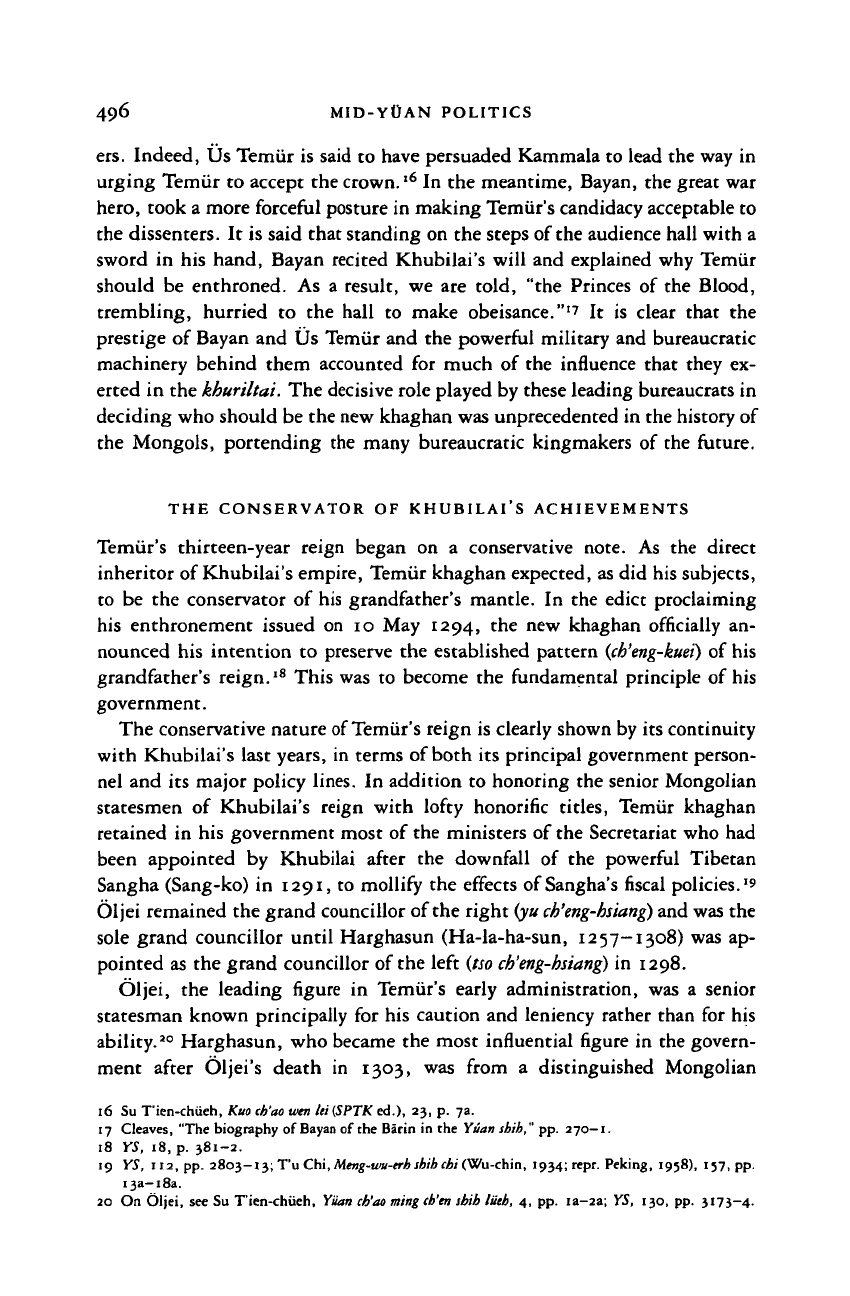
496 MID-YOAN POLITICS
ers.
Indeed, Us Temur is said to have persuaded Kammala to lead the way in
urging Temiir to accept the crown.
l6
In the meantime, Bayan, the great war
hero,
took a more forceful posture in making Temiir's candidacy acceptable to
the dissenters. It is said that standing on the steps of the audience hall with a
sword in his hand, Bayan recited Khubilai's will and explained why Temiir
should be enthroned. As a result, we are told, "the Princes of the Blood,
trembling, hurried to the hall to make obeisance."
17
It is clear that the
prestige of Bayan and Us Temiir and the powerful military and bureaucratic
machinery behind them accounted for much of the influence that they ex-
erted in the
khuriltai.
The decisive role played by these leading bureaucrats in
deciding who should be the new khaghan was unprecedented in the history of
the Mongols, portending the many bureaucratic kingmakers of the future.
THE CONSERVATOR OF KHUBILAI S ACHIEVEMENTS
Temiir's thirteen-year reign began on a conservative note. As the direct
inheritor of Khubilai's empire, Temiir khaghan expected, as did his subjects,
to be the conservator of his grandfather's mantle. In the edict proclaiming
his enthronement issued on 10 May 1294, the new khaghan officially an-
nounced his intention to preserve the established pattern
(cb'eng-kuei)
of his
grandfather's reign.
18
This was to become the fundamental principle of his
government.
The conservative nature of Temiir's reign is clearly shown by its continuity
with Khubilai's last years, in terms of both its principal government person-
nel and its major policy lines. In addition to honoring the senior Mongolian
statesmen of Khubilai's reign with lofty honorific titles, Temiir khaghan
retained in his government most of the ministers of the Secretariat who had
been appointed by Khubilai after the downfall of the powerful Tibetan
Sangha (Sang-ko) in 1291, to mollify the effects of Sangha's
fiscal
policies.'
9
Oljei remained the grand councillor of the right
(yu ch'eng-hsiang)
and was the
sole grand councillor until Harghasun (Ha-la-ha-sun, 1257-1308) was ap-
pointed as the grand councillor of the left
(tso ch'eng-hsiang)
in 1298.
Oljei, the leading figure in Temiir's early administration, was a senior
statesman known principally for his caution and leniency rather than for his
ability.
20
Harghasun, who became the most influential figure in the govern-
ment after Oljei's death in 1303, was from a distinguished Mongolian
16 Su Tien-chiieh, Kuo
ch'ao
wen UiiSPTK ed.), 23, p. 7a.
17 Cleaves, "The biography of Bayan of the Barin in the Yuan shih," pp.
270—
1.
18 YS, 18, p. 381-2.
19 YS, 112, pp. 2803-13; T'u Chi,
Meng-wu-erb
tbih cbi (Wu-ch'm, 1934; repr. Peking, 1958), 157, pp.
13a-18a.
20 On Oljei, see Su T'ien-chiieh, Yiian
ch'ao
ming
cb'en
sbib lueb, 4, pp. ia—2a; YS, 130, pp. 3173—4.
Cambridge Histories Online © Cambridge University Press, 2008
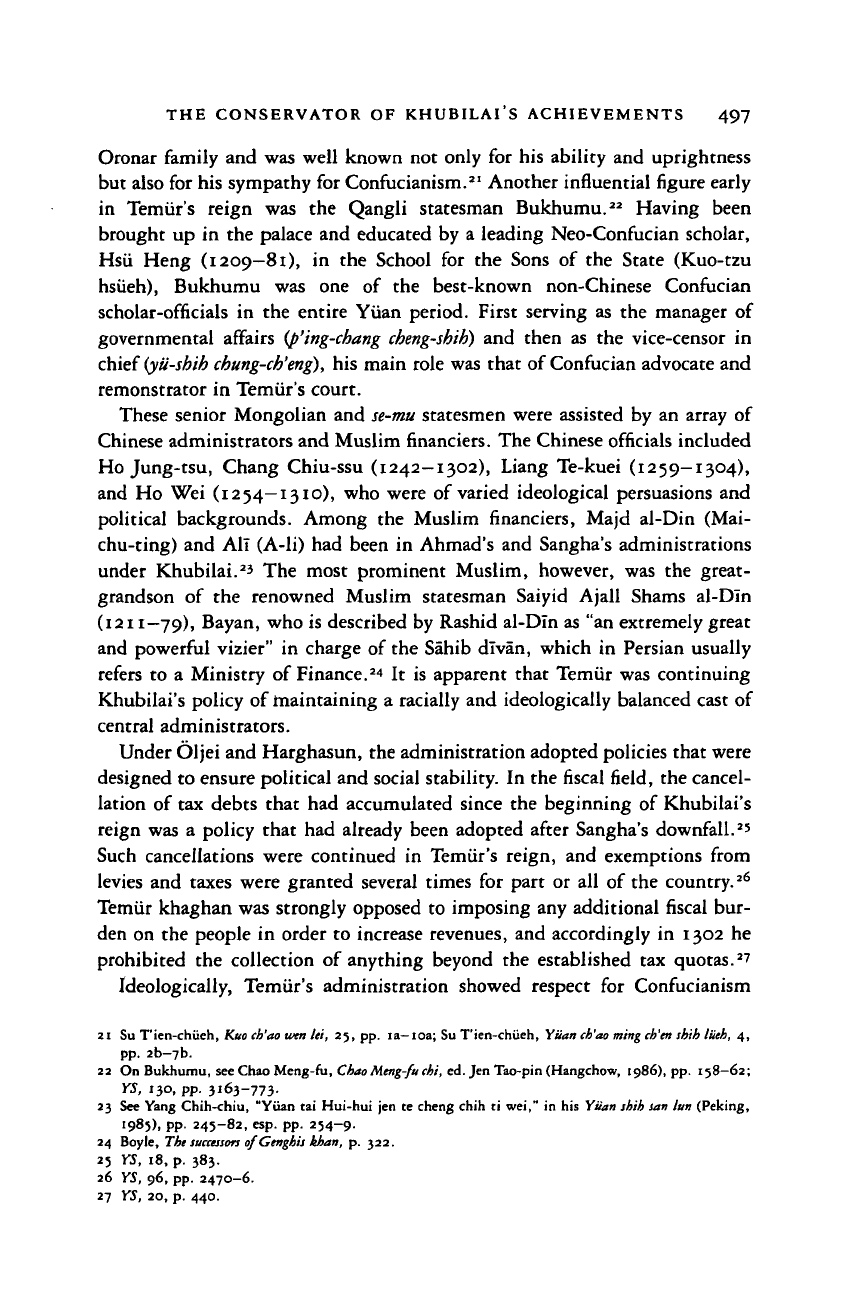
THE CONSERVATOR OF KHUBILAl'S ACHIEVEMENTS 497
Oronar family and was well known not only for his ability and uprightness
but also for his sympathy for Confucianism.
21
Another influential figure early
in Temiir's reign was the Qangli statesman Bukhumu.
22
Having been
brought up in the palace and educated by a leading Neo-Confucian scholar,
Hsu Heng (1209-81), in the School for the Sons of the State (Kuo-tzu
hsiieh),
Bukhumu was one of the best-known non-Chinese Confucian
scholar-officials in the entire Yuan period. First serving as the manager of
governmental affairs (p'ing-chang
cheng-shih)
and then as the vice-censor in
chief
(yu-shih
chung-ch'eng),
his main role was that of Confucian advocate and
remonstrator in Temiir's court.
These senior Mongolian and se-mu statesmen were assisted by an array of
Chinese administrators and Muslim financiers. The Chinese officials included
Ho Jung-tsu, Chang Chiu-ssu (1242-1302), Liang Te-kuei (1259-1304),
and Ho Wei (1254-1310), who were of varied ideological persuasions and
political backgrounds. Among the Muslim financiers, Majd al-Din (Mai-
chu-ting) and All (A-li) had been in Ahmad's and Sangha's administrations
under Khubilai.
2
^ The most prominent Muslim, however, was the great-
grandson of the renowned Muslim statesman Saiyid Ajall Shams al-Din
(1211—79), Bayan, who is described by Rashid al-DIn as "an extremely great
and powerful vizier" in charge of the Sahib divan, which in Persian usually
refers to a Ministry of Finance.
24
It is apparent that Temiir was continuing
Khubilai's policy of maintaining a racially and ideologically balanced cast of
central administrators.
Under Oljei and Harghasun, the administration adopted policies that were
designed to ensure political and social stability. In the fiscal field, the cancel-
lation of tax debts that had accumulated since the beginning of Khubilai's
reign was a policy that had already been adopted after Sangha's downfall.
25
Such cancellations were continued in Temiir's reign, and exemptions from
levies and taxes were granted several times for part or all of the country.
26
Temiir khaghan was strongly opposed to imposing any additional fiscal bur-
den on the people in order to increase revenues, and accordingly in 1302 he
prohibited the collection of anything beyond the established tax quotas.
27
Ideologically, Temiir's administration showed respect for Confucianism
21 Su T'ien-chiieh, Kuo
ch'ao
wen lei, 25, pp. la—10a; Su T'ien-chiieh, Yuan
ch'ao
ming
ch'en
shih
liieh,
4,
pp.
2b—7b.
22 On Bukhumu, see Chao Meng-fu, Chao
Meng-fu
chi,
ed. Jen Tao-pin (Hangchow, 1986), pp. 158—62;
YS, 130, pp. 3163-773.
23 See Yang Chih-chiu, "Yuan tai Hui-hui jen te cheng chih ti wei," in his Yiian shih san fan (Peking,
1985),
pp. 245-82, esp. pp. 254-9.
24 Boyle, The
successors
of Genghis khan, p. 322.
25 YS, 18, p. 383.
26 YS, 96, pp. 2470-6.
27 YS, 20, p. 440.
Cambridge Histories Online © Cambridge University Press, 2008
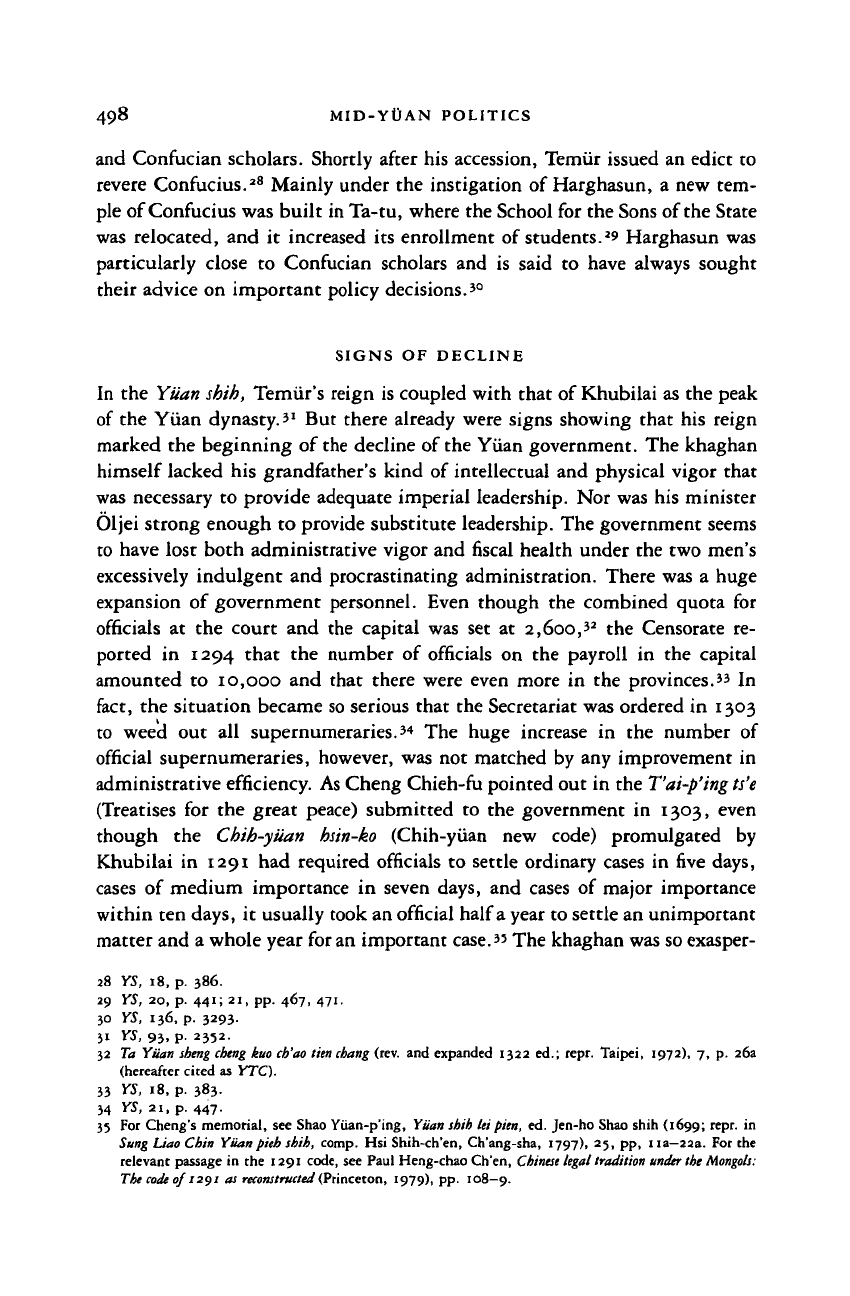
498 MID-YtiAN POLITICS
and Confucian scholars. Shortly after his accession, Temvir issued an edict to
revere Confucius.
28
Mainly under the instigation of Harghasun, a new tem-
ple of Confucius was built in Ta-tu, where the School for the Sons of
the
State
was relocated, and it increased its enrollment of students.
29
Harghasun was
particularly close to Confucian scholars and is said to have always sought
their advice on important policy decisions.'
0
SIGNS OF DECLINE
In the Yuan
shih,
Temiir's reign is coupled with that of Khubilai as the peak
of the Yuan
dynasty.
31
But there already were signs showing that his reign
marked the beginning of the decline of the Yuan government. The khaghan
himself lacked his grandfather's kind of intellectual and physical vigor that
was necessary to provide adequate imperial leadership. Nor was his minister
Oljei strong enough to provide substitute leadership. The government seems
to have lost both administrative vigor and fiscal health under the two men's
excessively indulgent and procrastinating administration. There was a huge
expansion of government personnel. Even though the combined quota for
officials at the court and the capital was set at 2,6oo,
32
the Censorate re-
ported in 1294 that the number of officials on the payroll in the capital
amounted to 10,000 and that there were even more in the provinces.
33
In
fact, the situation became so serious that the Secretariat was ordered in 1303
to weed out all supernumeraries.
34
The huge increase in the number of
official supernumeraries, however, was not matched by any improvement in
administrative efficiency.
As
Cheng Chieh-fu pointed out in the
T'ai-p'ing
ts'e
(Treatises for the great peace) submitted to the government in 1303, even
though the Chih-yiian hsin-ko (Chin-yuan new code) promulgated by
Khubilai in 1291 had required officials to settle ordinary cases in five days,
cases of medium importance in seven days, and cases of major importance
within ten days, it usually took an official half a year to settle an unimportant
matter and a whole year for an important case.
3
' The khaghan was so exasper-
28 YS, 18, p. 386.
29 YS, 20, p. 441; 21, pp. 467, 471.
30 YS, 136, p. 3293.
31 YS, 93, p. 2352.
32 Ta Yuan
sheng cheng
kuo ch'ao tien cbang (rev. and expanded 1322 ed.; repr. Taipei, 1972), 7, p. 26a
(hereafter cited as YTC).
33 YS, 18, p. 383.
34 YS, 21, p. 447.
35 For Cheng's memorial, see Shao Yiian-p'ing, Yuan shih Id pirn, ed. Jen-ho Shao shih (1699; repr. in
Sung Liao Chin Yuan pith shih, comp. Hsi Shih-ch'en, Ch'ang-sha, 1797), 25, pp,
1
ia—22a. For the
relevant passage in the 1291 code, see Paul Heng-chao Chen,
Chinese
legal tradition
under
the
Mongols:
The
code
of 1291 as
reconstructed
(Princeton, 1979), pp. 108—9.
Cambridge Histories Online © Cambridge University Press, 2008
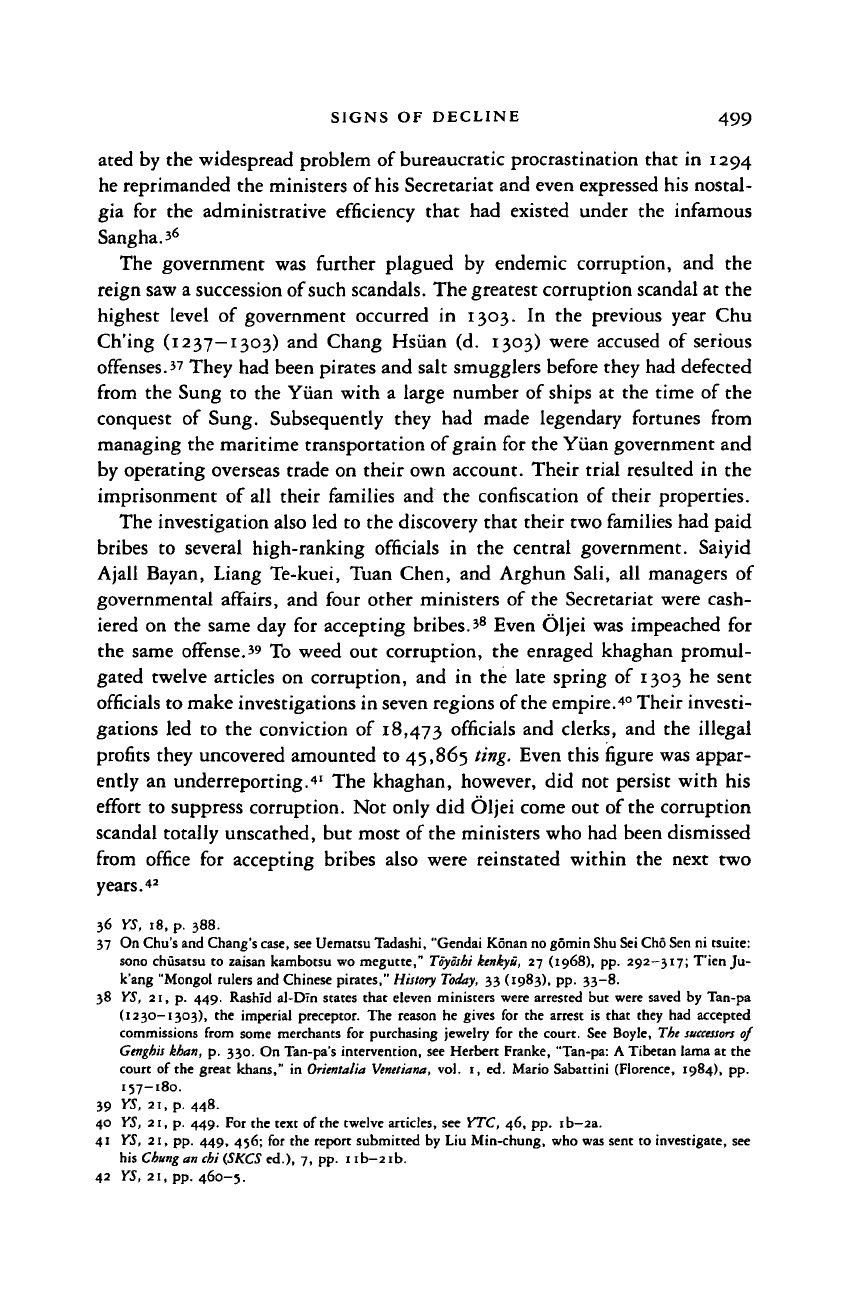
SIGNS OF DECLINE 499
ated by the widespread problem of bureaucratic procrastination that
in
1294
he reprimanded the ministers of his Secretariat and even expressed his nostal-
gia
for the
administrative efficiency that
had
existed under
the
infamous
Sangha.3
6
The government
was
further plagued
by
endemic corruption,
and the
reign saw a succession of such scandals. The greatest corruption scandal at the
highest level
of
government occurred
in
1303.
In the
previous year Chu
Ch'ing (1237-1303)
and
Chang Hsiian
(d.
1303) were accused
of
serious
offenses.
37
They had been pirates and salt smugglers before they had defected
from the Sung
to
the Yuan with
a
large number
of
ships
at
the time
of
the
conquest
of
Sung. Subsequently they
had
made legendary fortunes from
managing the maritime transportation of grain for the Yuan government and
by operating overseas trade on their own account. Their trial resulted
in
the
imprisonment
of
all their families
and the
confiscation
of
their properties.
The investigation also led to the discovery that their two families had paid
bribes
to
several high-ranking officials
in the
central government. Saiyid
Ajall Bayan, Liang Te-kuei, Tuan Chen, and Arghun Sali,
all
managers
of
governmental affairs, and four other ministers
of
the Secretariat were cash-
iered
on
the same day
for
accepting bribes.'
8
Even Oljei was impeached
for
the same offense.39 To weed
out
corruption, the enraged khaghan promul-
gated twelve articles
on
corruption,
and in
the late spring
of
1303
he
sent
officials to make investigations in seven regions of the empire.
40
Their investi-
gations
led to
the conviction
of
18,473 officials and clerks, and the illegal
profits they uncovered amounted to 45,865 ting. Even this figure was appar-
ently
an
underreporting.
4
' The khaghan, however,
did
not persist with
his
effort
to
suppress corruption. Not only did Oljei come out of the corruption
scandal totally unscathed, but most of the ministers who had been dismissed
from office
for
accepting bribes also were reinstated within
the
next
two
years.
42
36
YS,
18, p. 388.
37 On Chu's and Chang's case, see Uemacsu Tadashi, "Gendai Konan no gomin Shu Sei Cho Sen ni csuite:
sono chusatsu
to
zaisan kambotsu wo megutte,"
Toyoshi
kenkyu,
27
(1968), pp. 292-317; T'ien Ju-
k'ang "Mongol rulers and Chinese pirates," History Today, 33 (1983), pp. 33-8.
38
YS,
21,
p.
449. Rashid al-DIn states that eleven ministers were arrested but were saved
by
Tan-pa
(1230-1303),
the
imperial preceptor. The reason
he
gives
for the
arrest
is
that they had accepted
commissions from some merchants
for
purchasing jewelry
for
the court. See Boyle, The
successors
of
Genghis
khan,
p.
330. On Tan-pa's intervention, see Herbert Franke, "Tan-pa:
A
Tibetan lama at the
court
of
the great khans,"
in
Orientalia Venetiana,
vol. 1, ed.
Mario Sabattini (Florence, 1984),
pp.
157-180.
39 YS, 21, p. 448.
40
YS,
21,
p.
449. For the text of the twelve articles, see YTC, 46, pp. ib—2a.
4:
YS,
21, pp. 449, 456; for the report submitted
by
Liu Min-chung, who was sent
to
investigate,
see
his
Chung
an chi (SKCS ed.),
7,
pp.
1
ib—21b.
42 YS, 21, pp. 460-5.
Cambridge Histories Online © Cambridge University Press, 2008
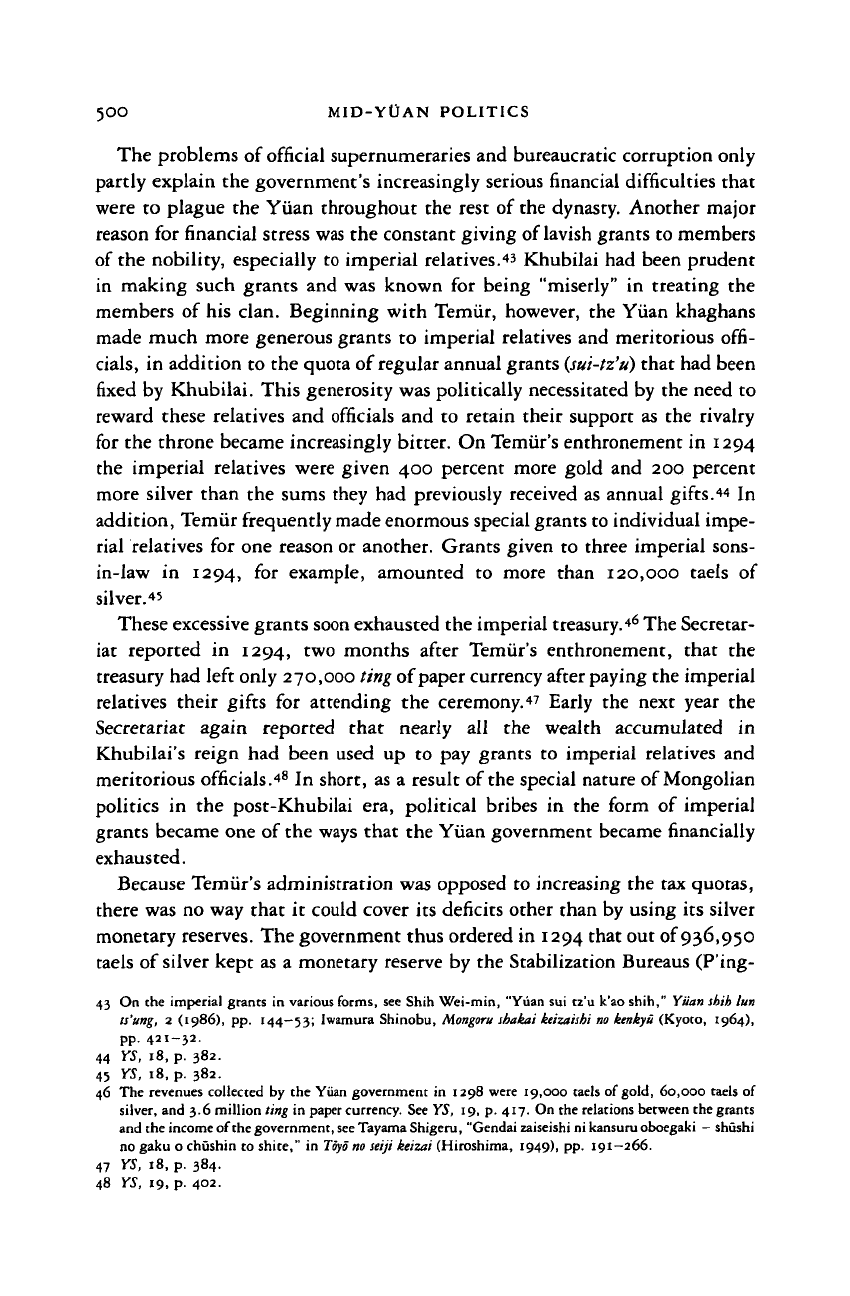
500 MID-YOAN POLITICS
The problems of official supernumeraries and bureaucratic corruption only
partly explain the government's increasingly serious
financial
difficulties that
were to plague the Yuan throughout the rest of the dynasty. Another major
reason for financial stress was the constant giving of
lavish
grants to members
of the nobility, especially to imperial relatives.
4
^ Khubilai had been prudent
in making such grants and was known for being "miserly" in treating the
members of his clan. Beginning with Temiir, however, the Yuan khaghans
made much more generous grants to imperial relatives and meritorious offi-
cials,
in addition to the quota of regular annual grants
(sui-tz'u)
that had been
fixed by Khubilai. This generosity was politically necessitated by the need to
reward these relatives and officials and to retain their support as the rivalry
for the throne became increasingly bitter. On Temiir's enthronement in 1294
the imperial relatives were given 400 percent more gold and 200 percent
more silver than the sums they had previously received as annual gifts.
44
In
addition, Temiir frequently made enormous special grants to individual impe-
rial relatives for one reason or another. Grants given to three imperial sons-
in-law in 1294, for example, amounted to more than 120,000 taels of
silver.
45
These excessive grants soon exhausted the imperial treasury.
46
The Secretar-
iat reported in 1294, two months after Temiir's enthronement, that the
treasury had left only 270,000
ting
of paper currency after paying the imperial
relatives their gifts for attending the ceremony.
47
Early the next year the
Secretariat again reported that nearly all the wealth accumulated in
Khubilai's reign had been used up to pay grants to imperial relatives and
meritorious officials.
48
In short, as a result of the special nature of Mongolian
politics in the post-Khubilai era, political bribes in the form of imperial
grants became one of the ways that the Yuan government became financially
exhausted.
Because Temiir's administration was opposed to increasing the tax quotas,
there was no way that it could cover its deficits other than by using its silver
monetary reserves. The government thus ordered in 1294 that out of 936,950
taels of silver kept as a monetary reserve by the Stabilization Bureaus (P'ing-
43 On the imperial grants in various forms, see Shih Wei-min, "Yuan sui tz'u k'ao shih," Yuan shih lun
ts'ung, 2 (1986), pp. 144—53; Iwamura Shinobu,
Mongoru
shakai keizaishi no kenkyu (Kyoto, 1964),
pp.
421-32-
44 YS, 18, p. 382.
45 YS, 18, p. 382.
46 The revenues collected by the Yiian government in 1298 were 19,000 taels of gold, 60,000 taels of
silver, and 3.6 million ting in paper currency. See YS, 19, p. 417. On the relations between the grants
and the income of the government, see Tayama Shigeru, "Gendai zaiseishi ni kansuru oboegaki - shushi
no gaku o chushin to shite," in
Toyo
no seiji ieizai (Hiroshima, 1949), pp. 191—266.
47 YS, 18, p. 384.
48 YS, 19, p. 402.
Cambridge Histories Online © Cambridge University Press, 2008

THE TRANSITION TO PEACE 5OI
chun k'u) of the various routes, only 192,450 taels should be kept for the
original purpose, and the rest was to be sent to the capital
—
apparently to
pay for current expenses. Four years later, another 200,000 ting were taken
out of the reserves. By 1299 the government's financial situation had deterio-
rated so much that half of its expenditures had to be covered by the monetary
reserves.
49
This draining of the monetary reserves in turn greatly weakened
the credibility of the paper currency system and touched off an inflationary
spiral that was even more harmful than the one that had taken place in the
I28OS.5°
THE TRANSITION TO PEACE
Temiir's reign was significant as the transition between a period of continuing
conquests and one of general peace. All the foreign conquests that Khubilai
had launched late in his reign had ended in failure. Apparently admitting
that further conquests would be fruitless and costly, Temiir khaghan reversed
the expansionist policy of his ancestors. Immediately after his enthronement
he canceled the campaign against Annam planned by Khubilai in the last year
of his reign and instead readmitted Annam as a tributary state. In 1298
Temiir rejected a recommendation to renew the invasion of Japan and instead
in the following year sent a monk to that island country on a peace mission.'
1
The only foreign campaigns launched in Temiir's reign were those against
Burma in 1300-1 and against Pa-pai hsi-fu, a small state in present northern
Thailand and eastern Burma, in 1301—3. Although both these campaigns
ended in failure, they were not attempts at foreign conquest. The campaign
against Burma was launched to punish the Burmese for dethroning a king
who had recognized Yuan suzerainty, and that against Pa-pai hsi-fu was a
police action against a border state that was expanding rapidly at the expense
of the Yuan.'
2
The greatest political and military achievement of Temiir khaghan was
the successful conclusion of the protracted and costly war with Khaidu (ca.
1235-1301) and Du'a (r. 1282-1307), the khans of the Ogodei and
Chaghadai khanates, who had begun to challenge Khubilai's authority as
49 YS, 18, pp. 387; 19, p. 417; 20, p. 426.
50
P'eng
Hsin-wei,
Chung-kuo huopi shih
(Shanghai,
1958),
pp.
409-10;
Maeda
Naonori,
"Gencho jidai
ni
okeru shihei
no
kachi
hendo,"
in his
Gencho
shi
no kmkyu
(Tokyo,
1973),
pp. 107-43.
51 YS, 208, p. 4630; 209, p. 4650.
52 YS, 211, p. 4639; Su
T'ien-chiieh,
Kuo
ch'ao
wen lei, 42, pp.
32a-33a;
Yuan cb'ao cheng mien
lit
(.TSCC
ed.).
This work
has
been translated into
French;
see
Edouard
Huber,
"Etudes
indochinoises:
V.
—
La
Fin de la
dynastic
de
Pagan,"
Bulletin
de I'kolt
franfaisectextremt-orient,
9(1909),
pp.
633-80,
esp. pp.
662-80.
Cambridge Histories Online © Cambridge University Press, 2008
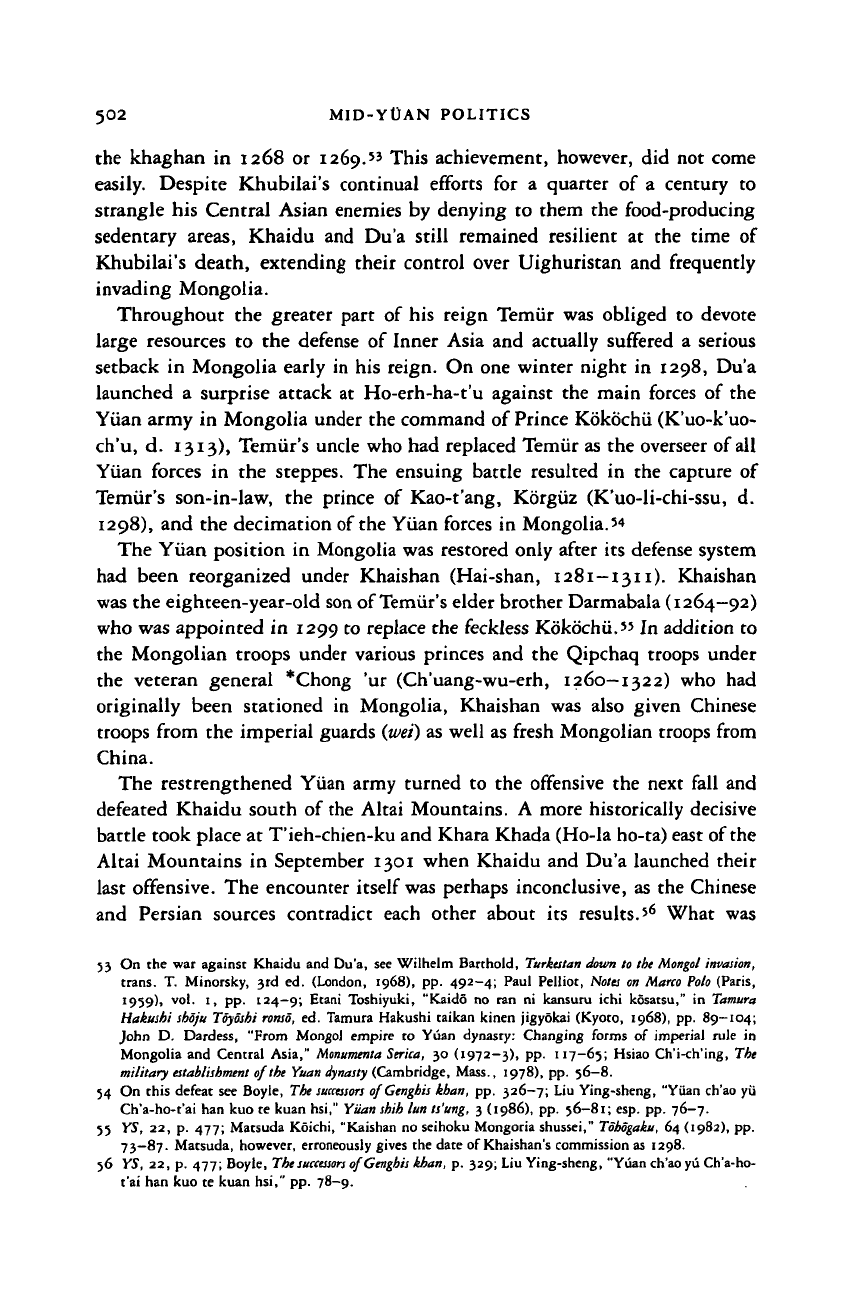
502 MID-YOAN POLITICS
the khaghan in 1268 or i26c>.
5}
This achievement, however, did not come
easily. Despite Khubilai's continual efforts for a quarter of a century to
strangle his Central Asian enemies by denying to them the food-producing
sedentary areas, Khaidu and Du'a still remained resilient at the time of
Khubilai's death, extending their control over Uighuristan and frequently
invading Mongolia.
Throughout the greater part of his reign Temiir was obliged to devote
large resources to the defense of Inner Asia and actually suffered a serious
setback in Mongolia early in his reign. On one winter night in 1298, Du'a
launched a surprise attack at Ho-erh-ha-t'u against the main forces of the
Yuan army in Mongolia under the command of Prince Kokochii (K'uo-k'uo-
ch'u, d. 1313), Temiir's uncle who had replaced Temiir as the overseer of all
Yuan forces in the steppes. The ensuing battle resulted in the capture of
Temiir's son-in-law, the prince of Kao-t'ang, Korgiiz (K'uo-li-chi-ssu, d.
1298),
and the decimation of the Yuan forces in Mongolia.
54
The Yuan position in Mongolia was restored only after its defense system
had been reorganized under Khaishan (Hai-shan, 1281-1311). Khaishan
was the eighteen-year-old son of Temiir's elder brother Darmabala (1264-92)
who was appointed in 1299 to replace the feckless Kokochii.« In addition to
the Mongolian troops under various princes and the Qipchaq troops under
the veteran general *Chong 'ur (Ch'uang-wu-erh, 1260-1322) who had
originally been stationed in Mongolia, Khaishan was also given Chinese
troops from the imperial guards
(wet)
as well as fresh Mongolian troops from
China.
The restrengthened Yuan army turned to the offensive the next fall and
defeated Khaidu south of the Altai Mountains. A more historically decisive
battle took place at T'ieh-chien-ku and Khara Khada (Ho-la ho-ta) east of the
Altai Mountains in September 1301 when Khaidu and Du'a launched their
last offensive. The encounter itself
was
perhaps inconclusive, as the Chinese
and Persian sources contradict each other about its results.
56
What was
53 On the war against Khaidu and Du'a, see Wilhelm Barthold,
Turkestan
down to the Mongol invasion,
trans.
T. Minorsky, 3rd ed. (London, 1968), pp. 492—4; Paul Pelliot, Notes on Marco Polo (Paris,
1959),
vol. i, pp. 124—9; Et
an
i Toshiyuki, "Kaido no ran ni kansuru ichi kosatsu," in Tamura
Hakushi shiju Tbyoshi
ronso,
ed. Tamura Hakushi taikan kinen jigyokai (Kyoto, 1968), pp. 89-104;
John D. Dardess, "From Mongol empire to Yuan dynasty: Changing forms of imperial rule in
Mongolia and Central Asia,"
Monumenta
Serica, 30 (1972—3), pp. 117—65; Hsiao Ch'i-ch'ing, The
military establishment of the Yuan dynasty (Cambridge, Mass., 1978), pp. 56—8.
54 On this defeat see Boyle, The
successors
of
Genghis
khan, pp. 326—7; Liu Ying-sheng, "Yuan ch'ao yii
Ch'a-ho-t'ai han kuo te kuan hsi," Yuan shih lun ts'ung, 3 (1986), pp.
56—81;
esp. pp. 76—7.
55 YS, 22, p. 477; Matsuda Koichi, "Kaishan no seihoku Mongoria shussei," Tohogaku, 64 (1982), pp.
73—87. Matsuda, however, erroneously gives the date of Khaishan's commission as 1298.
56 YS, 22, p. 477; Boyle,
The successors
of
Genghis
khan, p. 329; Liu Ying-sheng, "Yuan ch'ao yii Ch'a-ho-
t'ai han kuo te kuan hsi," pp. 78-9.
Cambridge Histories Online © Cambridge University Press, 2008
